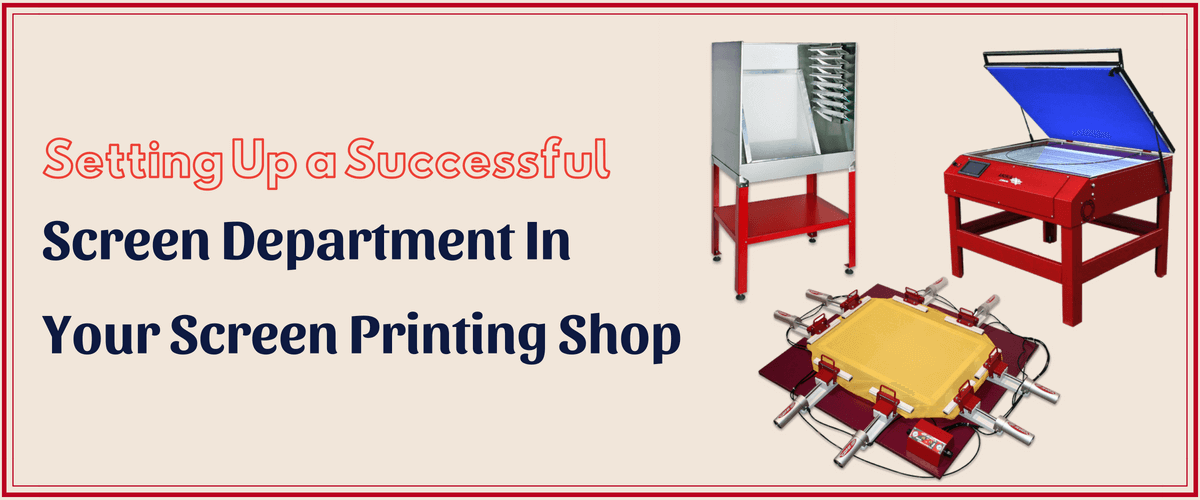

Revolucionando la industria de la serigrafía a través de tecnología de punta y servicio de calidad
Anatol Equipment Manufacturing Co.
1429 S Shields Dr
Waukegan, IL 60085


Revolucionando la industria de la serigrafía a través de tecnología de punta y servicio de calidad
Anatol Equipment Manufacturing Co.
1429 S Shields Dr
Waukegan, IL 60085

A quality screen print begins with a quality screen, and a quality screen requires a smart and efficient screen department!
There’s nothing quite like seeing a squeegee glide across a screen, depositing a perfect print onto a fresh substrate. While the process might come to life on the presses, everyone knows that the workhorse of any screen printing shop is the screen making department.
Creating artwork, reclaiming screens, printing negatives and exposing screens to create stencils — those processes are what make your final prints a success or a failure. To ensure that your screen making goes as smoothly and as efficiently as possible, you have to set up your screen making department for success. Here’s how!
Too often, screen printing shops opt for what’s cheapest, rather than what’s right. That includes screens that will break down prematurely, mesh counts that aren’t ideal for the type of printing they do, household chemicals instead of screen printing chemicals for cleaning screens and outdated exposure units when their shop aims to produce highly detailed prints. These cut corners might save you money up front, but they can cost your shop quite a bit down the road. When you don’t use the proper supplies and equipment, you don’t get the quality prints you’re looking for. That leads to waste that can cost you money. The wrong equipment also can slow down your production process, costing you money both in manpower and in orders that your shop can’t handle because your production isn’t fast enough to meet demand.
So how do you choose equipment that will optimize your screen making process? First, think about the types of prints you most frequently do or that you would like to focus on doing in your shop. When you can envision the types of prints you want to achieve, you can begin to look at the types of screens and equipment it will take you to meet those goals. When you talk to suppliers, don’t rush to ask about price — while price can be an important factor, you want to talk to your suppliers about your needs and get their advice on the products that will meet your needs.
When it comes to efficiency, and creating quality screens, the key is to establish designated work zones for each screen making task and to lay out those zones in a way that optimizes the work flow of your screen printing department. Generally, screen making departments require areas for creating artwork; prepping, repairing and retensioning screens; reclaiming and washing out screens; coating screens; exposing screens; and drying screens. The layout of your screen making department will largely be influenced by the space available within your shop. Regardless of the size or shape of the space, the goal is to create a layout that allows your screen process to flow from beginning to end, usually in either a linear or horseshoe shape.
Because so much goes into screen making, and because flaws in screens mean flaws in prints, controlling the environment in your screen printing shop will have a positive impact on your screen making quality and efficiency. The types of environmental controls will depend on the “zone” of the screen making department. Through the entire department, dust control is clutch; it can be achieved by sealing walls, painting them with an enamel that won’t hold dust, using an air filter and taking the time to regularly clean the space. Where screens are being coated and exposed, you’ll need to be sure that you’re filtering out or eliminating UV light to avoid accidental or partial exposure. In the screen drying room, dehumidifiers can help keep humidity at bay so screens dry faster and dry completely. In your “wet” area — where screens are washed out or reclaimed — rubber mats can help avoid slips and keep the staff moving confidently and efficiently while they work.
Setting up your screen making department the right way is an investment of time, and even money. But the time and money you invest in your screen making shop will be well spent. You’ll reap dividends by having less waste in your shop due to improperly produced screens, less than ideal equipment and increased quality control, and you will see your production times increase because your shop will be set up to maximize your screen making process. Remember: Successful screen printing can’t happen without quality screens, and quality screens can’t happen without a screen making department that’s been primed for success.
Your message was successfully sent!